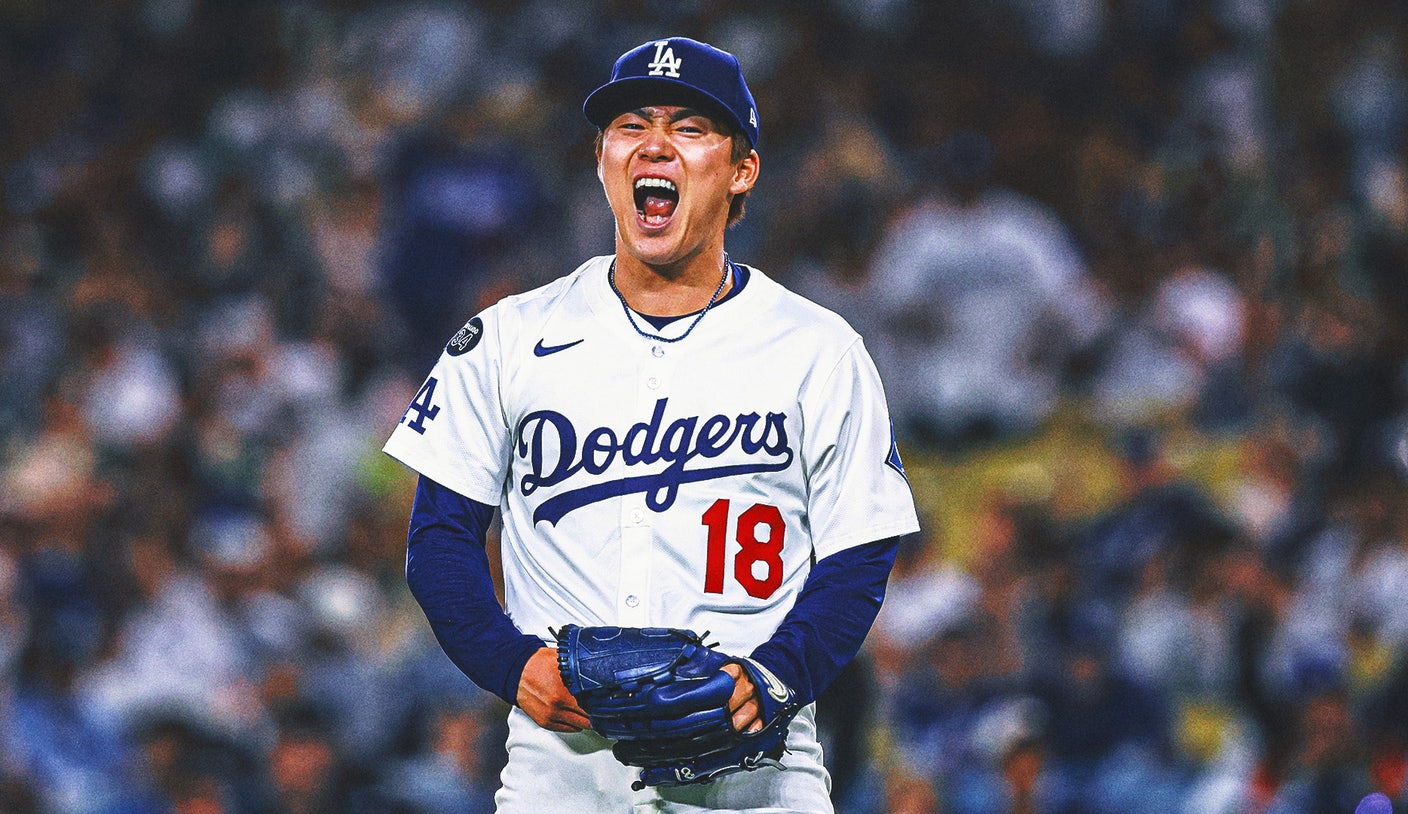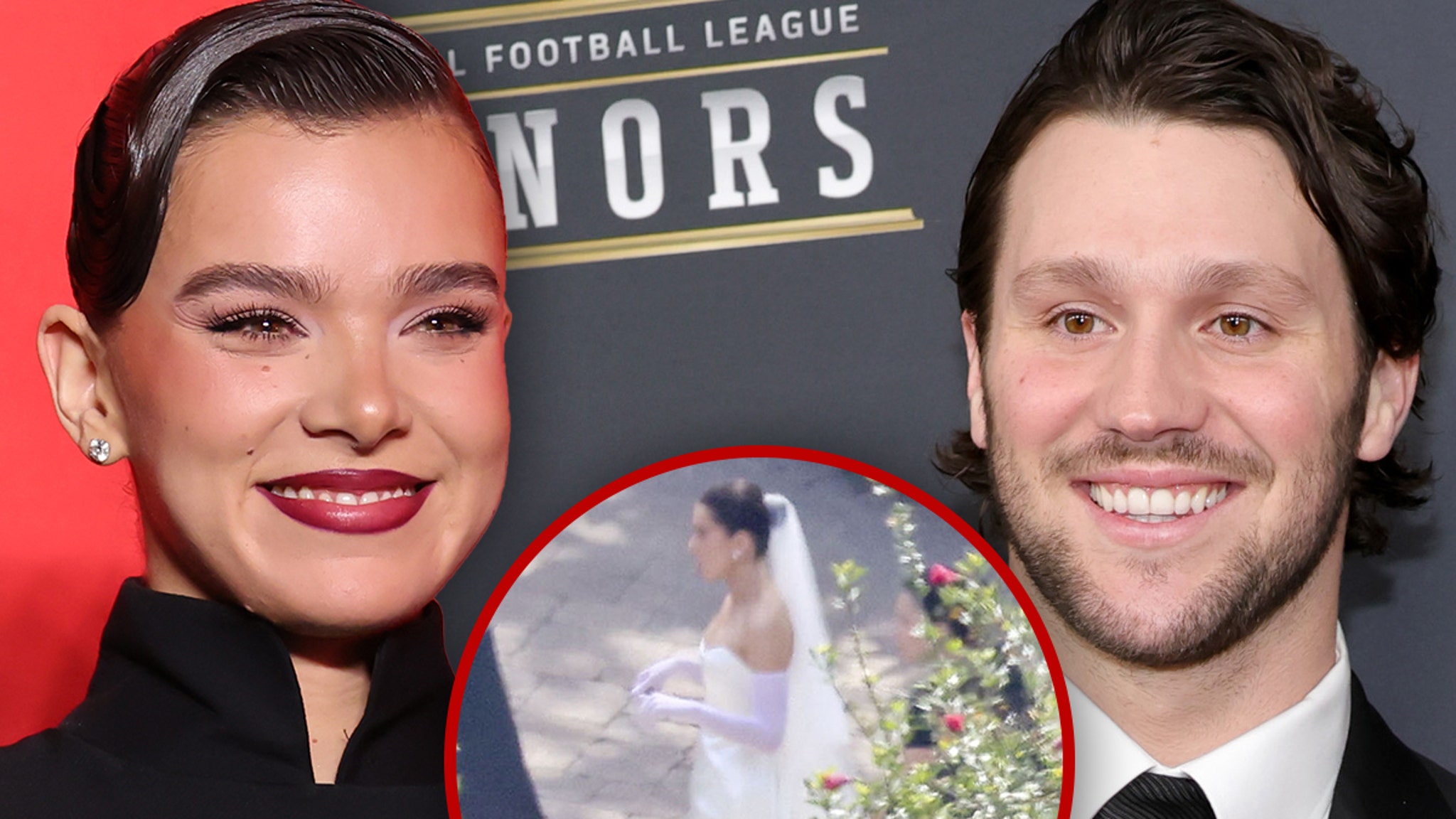‘He’s our ace’: Inside Yoshinobu Yamamoto’s crucial second-year rise with the Dodgers
One of the early contenders for the National League Cy Young Award stands under 6 feet tall. He defies convention, not only with his size but also with the way he eschews traditional training methods in favor of more unorthodox routines.
In the time between Yoshinobu Yamamoto’s starts, every throw is calculated, every move treated with precision and care. He favors flexibility, movement and coordination over brawn.
You won’t find him lifting weights, but you might see him on the warning track launching javelins through the sky or treating long-toss sessions as if he were on the mound finishing off a complete-game shutout.
That hasn’t happened yet through 29 career big-league starts, though he’s getting increasingly closer.
This month alone, Yamamoto has taken one no-hitter into the sixth inning and another into the seventh. He has gone at least six innings in seven of his last nine starts, amassed the lowest ERA among qualified National League starters and become the steadying force a beleaguered rotation needs him to be.
He is developing into the star the Dodgers envisioned when they made him the highest-paid pitcher in the sport a year ago.
“He’s our ace,” Dave Roberts put succinctly.

Dodgers manager Dave Roberts embraces pitcher Yoshinobu Yamamoto after holding the Yankees to one run in Game two of the World Series at Dodger Stadium. (Robert Gauthier/Los Angeles Times via Getty Images)
The Dodgers manager is careful not to throw that term around flippantly. He knows how few of them there are in the big leagues and the expectations the label brings. An ace needs a track record of success. An ace needs to handle both lefties and righties with aplomb. An ace needs to go deep into games.
And, sometimes, an ace needs to be the stopper.
That’s the role Yamamoto played on May 20, with the Dodgers on a four-game losing skid during which their starters had allowed 16 runs in 15 innings. Most of the pitchers comprising that group were not the ones the Dodgers envisioned on the mound when they retooled this winter. Yamamoto and Dustin May are the only active starters remaining from the team’s season-opening rotation.
“You just can’t lose on nights that Yamamoto throws,” Roberts said.
That night, Yamamoto did his part to ensure they didn’t.
Clinging to a 1-0 lead after holding the Diamondbacks hitless through six innings, trouble struck for Yamamoto when Ketel Marte roped a single off the wall to start the seventh. A wild pitch and a couple groundouts moved Marte to third before Yamamoto issued a four-pitch walk to Gabriel Moreno.
The go-ahead run was on, Yamamoto’s pitch count had risen over 100, and a decision loomed for Roberts.
“It’s not about pitch count, it’s not about third time through,” Roberts reasoned. “It’s about, ‘He’s our best option.’”
In a choice he probably wouldn’t have made a year ago, Roberts left him in.
One batter later, Yamamoto rewarded his manager’s faith.
On his career-high 110th pitch, Yamamoto finished off his seventh scoreless inning with his ninth strikeout of the night, a 92-mph cutter at the bottom of the zone that glanced off the bat of Pavin Smith and into the glove of catcher Will Smith. Yamamoto strolled off the mound to chants of “Yo-shi” echoing throughout Dodger Stadium.
It was one of five starts this year in which Yamamoto has gone at least six innings without allowing an earned run; he had three such starts all of last season.
“He’s a completely different guy now,” Roberts told me. “The demeanor on the mound, there’s just an even-keeled heartbeat out there. I watch our pitchers and players very closely, and there’s a lot of things that he does after a big inning or a big out or a certain situation that he’s always looking for more. It’s palpable. I can see it.”
What does that look like?
“He’s standing a little bit taller,” Roberts explained. “I really do see it. I know that’s figurative, but he’s standing taller.”
It took time for that confidence to develop.
Yamamoto enjoyed a strong debut season last year, though the $325 million price tag begged for more. The pinpoint command that helped him win three straight Sawamura Awards — Nippon Professional Baseball’s equivalent to the Cy Young Award — fluctuated. Yamamoto finished the year with a 3.00 ERA, but he went more than six innings only twice and threw fewer than 100 innings in the regular season after missing nearly three months with a rotator cuff strain.
Still, he was at his best when the Dodgers needed him most.
Specifically, he was at his best against the team he’ll see again Sunday.
The first time Yamamoto faced the Yankees was a turning point in his rookie year. Many of his teammates and coaches recall his seven shutout innings in the Bronx last June as the moment that demonstrated his ability to handle the pressure of baseball’s biggest stage.
It might have convinced Yamamoto, too.
“It just provided him the confidence to know that he can pitch in any sort of game environment or setting,” Dodgers assistant pitching coach Connor McGuiness said.
The second time he faced the Yankees, Yamamoto proved it.
In his lone start of the World Series, he delivered 6.1 innings of one-run ball in a 4-2 win.
That elite version of the Japanese sensation is becoming the norm now, all the more important for a Dodgers rotation that ranks 22nd in ERA. Yamamoto is the only healthy starter on the Dodgers roster with an ERA under 4.00.
“He has, quite honestly, some of the best command I’ve ever seen,” McGuiness said. “The comfort level’s through the roof with the ball, the environment, the pitch clock, the catchers, everything.”
Yamamoto is inducing more whiffs and soft contact than he did last year and has the third-highest year-over-year increase in groundball rate among qualified starters. He’s commanding his fastball more expertly, and he’s devastating opponents with his splitter, which has become one of the nastiest offerings in the sport.
“I’m kind of in awe of how well he executes,” Tommy Edman said. “He’s able to dot the outside corner whenever he wants, and once he hits that corner, he has the splitter off of it. I don’t really know how I’d attack him as a hitter.”
Yamamoto’s consistency and comfort have risen in conjunction.
Many Dodgers players, coaches and personnel have noted how much more at ease Yamamoto appears both on and off the field compared to where he was early last year as a 25-year-old in a new league, with a new team, learning a new language, throwing a new baseball and adjusting to a new schedule.
“I think he’s more relaxed now,” Teoscar Hernandez said. “He makes jokes. He plays around.”
“He’s just a guy that’s very comfortable in his own skin,” Kike Hernandez added. “He’s got a little bit of an unorthodox routine, but he doesn’t really care. He’s just confident.”
Yamamoto’s singular routine hasn’t changed, but it’s one that now has proof of concept.
“The first year I think everybody kind of spent staring at each other, like, ‘Are you judging me?’” said Brandon McDaniel, Dodgers vice president of player performance. “Obviously, we want everybody to feel super comfortable when they come in here and do the things they can do to be successful, and obviously he was extremely successful. So, it’s been really cool to see that fit in now, where it’s just like, that’s how he goes about his business. And it works really, really well.”

Yoshinobu Yamamoto is the only healthy starter on the Dodgers roster with an ERA under 4.00. (Photo by Ronald Martinez/Getty Images)
Interest gets piqued when a player Yamamoto’s size — around 5-foot-10, no more than 180 pounds — is routinely pumping fastballs over 95 mph. Occasionally, both Dodgers players and personnel will try out his javelin toss.
“Especially in the minor leagues,” McDaniel said. “I went on a rehab assignment with him last year and saw a clubbie go out and do it. I think everybody’s super curious about what it does and how to go about it. I don’t think anybody’s, like, doing them regularly, but I think there’s a lot of curiosity, like, ‘That little guy throws that hard, that much?’”
That intrigue extends to the teams who visit Dodger Stadium.
When the Brewers traveled to Los Angeles last July, Clayton Kershaw suggested to Milwaukee manager Pat Murphy that he watch Yamamoto’s catch play. Murphy studied intently and marveled at the precision.
“It’s, f—ing, an art,” Murphy said. “It’s like Steph Curry shooting.”
Yamamoto knows what works for him.
Now, after a year in the majors, those around him do, too.
“We understand it better,” Dodgers general manager Brandon Gomes said. “He gets how it all works within the day, because our schedules are so different between here and the NPB, with travel and day games and all that. Overall, his level of comfort with what’s going on, everything leading up to the game and in between starts, is at a much higher level.”
After a year of experience, Gomes also believes that Yamamoto has a better feel now for when to dial in and when to let loose. Gomes always thought Yamamoto had a welcoming nature to him that made him easy to gravitate toward, even with the language barrier, which is becoming less of an impediment.
Teoscar Hernández said Yamamoto clearly knows a lot more English this year compared to last. Now, he can ask Yamamoto short questions and get a response.
Yamamoto’s teammates notice the effort he is putting in.
“I know for a fact sometimes after games at night he’ll do a one-hour English lesson,” Kiké Hernández said. “He can kind of get by with what he has. I would say I played with like seven Japanese players, maybe more, and he is by far the most dedicated with English class. I think that by next year he’s going to be able to pretty much be fluent.”
“I was told that he does English classes like three times a week,” reliever Alex Vesia added. “You can have a long conversation with him. It’s very normal, and he understands the English jokes and sarcasm. So, you can go back and forth and have a fun conversation.”
It remains a work in progress. Others have not found it quite so easy to communicate just yet.
“You can kind of see a little personality on the field, but even then, there’s so many guys that are completely different on the field than off the field,” Mookie Betts said. “To be honest, I know he’s a great dude, but it’s hard to really get to know him because of the language barrier.
“Maybe one day,” Betts continued. “We’ve got a long time together.”
Betts signed a 12-year extension in 2020 and immediately helped lift the Dodgers to a World Series championship.
Last year, Yamamoto did the same, thriving on the biggest stage in October as the last standing member of the team’s season-opening rotation.
This year represents another leap forward. Gomes has noticed Yamamoto developing a better understanding for gameplanning. Yamamoto said he can move
As scrupulous as he is with his preparation, Yamamoto can be similarly meticulous when critiquing his performance.
“He’s been frustrated by a few pitches here and there,” McGuiness said. “It’s like, my goodness, man, take a step back and look at what you’ve done.”
Given all the injuries in the Dodgers’ rotation, there’s an argument to be made there’s no player more vital to the team’s success. You could double Yamamoto’s 1.97 ERA, and he would still have the lowest mark among active starters on the roster.
His work in March and April, when he posted a 1.06 ERA over his first six starts of the year, earned him his first career Pitcher of the Month Award.
Eleven starts into the season, he is still pitching at a Cy Young level.
He struck out 10 batters in seven scoreless innings in Texas on April 18. He allowed one hit in six scoreless innings in Atlanta on May 2. Over his last two starts, he has allowed two runs on four hits with 16 strikeouts in 13 innings.
And on Sunday, for the first time in 2025, he’ll match up again against the team that helped build his belief and reputation.
“In his first year, he pitched on the biggest stage,” Max Muncy said, “and he was great. For him to know he can do that, it has to add a ton of confidence.”
Rowan Kavner is an MLB writer for FOX Sports. He previously covered the L.A. Dodgers, LA Clippers and Dallas Cowboys. An LSU grad, Rowan was born in California, grew up in Texas, then moved back to the West Coast in 2014. Follow him on X at @RowanKavner.

Get more from Major League Baseball Follow your favorites to get information about games, news and more
editor's pick
latest video
Sports News To You
Subscribe to receive daily sports scores, hot takes, and breaking news!




